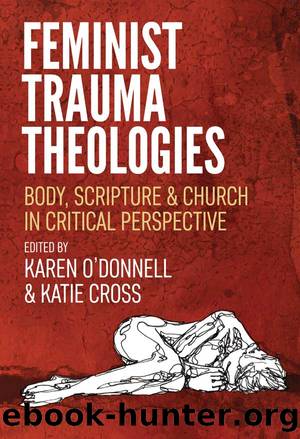Feminist Trauma Theologies by O'Donnell Karen;Cross Katie; & Katie Cross

Author:O'Donnell, Karen;Cross, Katie; & Katie Cross
Language: eng
Format: epub
Publisher: Hymns Ancient & Modern
Published: 2020-02-12T16:00:00+00:00
Letâs discuss entertainment as male propaganda, shall we? Questions: Can you imagine if manâs history was only depicted, shown, and viewed through a womanâs perspective? Do you think there has even been a film where only women were hired to tell a âmanâs storyâ? The answers are No.24
The second-century text of the Acts of Paul and Thecla (APTh) introduces us to the heroine and protagonist Thecla. On hearing the apostle Paul preach, Thecla â an aristocratic woman â becomes entranced and, despite great opposition, renounces her family and fiancé to follow Paul. Thecla is punished for this rebellion by sentence of death and she is thrown into the arena. Once in the arena, the beautiful virgin is stripped naked (APTh 22, 33) and forced to âmountâ the pyre (APTh 22). Scopophilia and patriarchal norms coalesce. The pleasure in this text is immediately geared towards the heterosexual, patriarchal male, and Thecla, the would-be martyr, doubles up as a pin-up girl. Nevertheless, through miraculous intervention, Thecla is protected by God and survives. She leaves her home town and goes on her way only to be threatened with rape by the high-born man Alexander (APTh 26). For resisting the unwanted physical attention of this powerful man, Thecla is condemned to death for a second time. Once again, Thecla is thrown into the arena. However, no matter what they do to this woman, she refuses to die. Alexander, therefore, sadistically informs the Governor that he has two particularly vicious bulls that will undoubtedly ensure this uppity woman is put firmly in her place: read âtrampled well and truly into the groundâ. The naked Thecla, a beautiful, desirable young virgin, is thus unceremoniously tied by her feet between two vicious bulls, in an arena full of spectators (APTh 35).25 In adding this gratuitous element, the narrator once again invites the privileged heterosexual male gaze on to the scene to titillate his audience. This is a gaze that carries with it the power of objectification, possession and destruction; a power clearly lacking in the female gaze within this text.26
It is important to note at this stage that this is a second-century text. In this period, the bodies of chaste women were concealed. Women and girls of citizen status were rigorously segregated; sexual and social mores were controlled by strict notions of etiquette and propriety, with a sharp distinction between public (for male) and private (for women).27 Thecla, a high-born woman and virgin, suffers the humiliation and torment usually reserved for shameless women who transgress social, sexual and societal norms.28 Such exposure deliberately plays on shameful undertones and serves as an instrument of male control of women and their sexuality; a realm designated as womenâs greatest vulnerability.29
It is also difficult to escape the symbolism of the bulls. Jeffrey Henderson notes that in antiquity, bulls represent the phallic.30 We are told that red-hot irons are applied to their underbellies to enrage them (APTh 35). Just as the bulls represent the phallic, so too do the red-hot irons that are used to torturously brand them.
Download
This site does not store any files on its server. We only index and link to content provided by other sites. Please contact the content providers to delete copyright contents if any and email us, we'll remove relevant links or contents immediately.
Never by Ken Follett(2872)
The Man Who Died Twice by Richard Osman(2289)
Machine Learning at Scale with H2O by Gregory Keys | David Whiting(2264)
Fairy Tale by Stephen King(2058)
Will by Will Smith(2032)
Reminders of Him: A Novel by Colleen Hoover(1869)
Rationality by Steven Pinker(1760)
The Stranger in the Lifeboat by Mitch Albom(1529)
The Becoming by Nora Roberts(1323)
Friends, Lovers, and the Big Terrible Thing by Matthew Perry(1321)
New Morning Mercies: A Daily Gospel Devotional by Paul David Tripp(1301)
A Short History of War by Jeremy Black(1295)
HBR's 10 Must Reads 2022 by Harvard Business Review(1251)
The Strength In Our Scars by Bianca Sparacino(1234)
The Fall of Babel by Josiah Bancroft(1230)
Can't Hurt Me: Master Your Mind and Defy the Odds - Clean Edition by David Goggins(1218)
515945210 by Unknown(1205)
Fear No Evil by James Patterson(1106)
Love on the Brain by Ali Hazelwood(1088)
